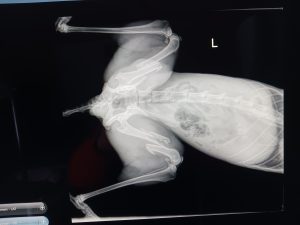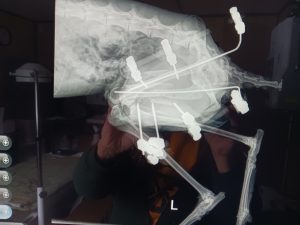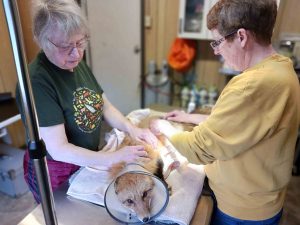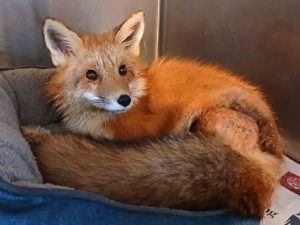
Early in the morning on January 31, 2024, Nigel spotted a fox lying motionless in a snowbank by the roadside. The fox was wet, dirty, and matted with road sand. Running late, Nigel continued on his way, but the image of the fox lingered in his mind.
Later that afternoon, as he drove back, Nigel saw the fox again. This time, the animal had shifted position but was shivering from the cold. As Nigel cautiously approached, the fox lifted its head, meeting his gaze with sad, helpless eyes. Weak and in obvious pain, the fox barely moved.
Nigel had experience with wildlife rescue and knew what to do. He called Woodlands Wildlife Sanctuary for instructions on safely containing the injured animal. Following their guidance, he gently wrapped the fox in his jacket, placed him in a box, and set off toward the sanctuary.

The fox, who didn’t resist at all, underwent X-rays that revealed severe injuries: both femurs were fractured and splintered, with contracted bones indicating these were older injuries. The fox had been suffering for days.
Dr. Cox, a wildlife veterinarian working with the sanctuary, was en route to the airport and unable to perform surgery for another four days. After consulting with the sanctuary staff, they decided to keep the fox comfortable with pain medication, hoping he would hold on until Dr. Cox could operate.
On the day of surgery, Dr. Cox was able to pin both legs in under five hours. Afterward, his legs felt strong, his pain diminished, and he began showing signs of recovery. He moved around more, even showing interest in returning to the wild. However, his recovery took a turn: the pins in his left leg did not hold and had to be removed.

In an attempt to stabilize the leg, the team applied a tight wrap, but one night, the fox—now named Tavi—chewed through the bandage, creating sores and lesions. After some time, the wounds healed, and the pins in his other leg were successfully removed. Currently, discussions are underway about performing a bone marrow graft to give Tavi’s left leg another chance at healing.
While amputation remains a last resort, Tavi will still be able to return to the wild even if he has only three legs. His second chance at life in the wild would not have been possible without the compassionate care at Woodlands Wildlife Sanctuary.
